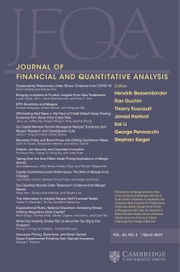No CrossRef data available.
Article contents
Swimming Upstream: Struggling Firms in Corrupt Cities
Published online by Cambridge University Press: 23 January 2025
Abstract
We find that a corrupt local environment amplifies the effects of financial distress. Following regional spikes in financial misconduct, credit becomes more difficult to obtain for local borrowers—even those not implicated themselves. This is particularly harmful for cash-constrained firms, which cut investment more sharply and lay off more workers during industry downturns. We also find that local clustering of financial misconduct is a risk factor for bankruptcy.
Information
- Type
- Research Article
- Information
- Journal of Financial and Quantitative Analysis , Volume 60 , Issue 7 , November 2025 , pp. 3311 - 3343
- Creative Commons
- This is an Open Access article, distributed under the terms of the Creative Commons Attribution licence (http://creativecommons.org/licenses/by/4.0), which permits unrestricted re-use, distribution and reproduction, provided the original article is properly cited.
- Copyright
- © The Author(s), 2025. Published by Cambridge University Press on behalf of the Michael G. Foster School of Business, University of Washington
Footnotes
We thank Jonathan Karpoff, Allison Koester, Scott Lee, and Gerald Martin for making their data on financial misconduct available. We also thank Jonathan Karpoff, Brian Melzer, Florian Schulz, Stefan Zeume, and seminar participants at University of Miami, University of Wisconsin (Milwaukee), 2015 ASU Sonoran Conference, 2015 UNC/Duke Corporate Finance Conference, 2015 Summer Real Estate Symposium, and 2016 American Finance Association meeting for useful comments and suggestions.

